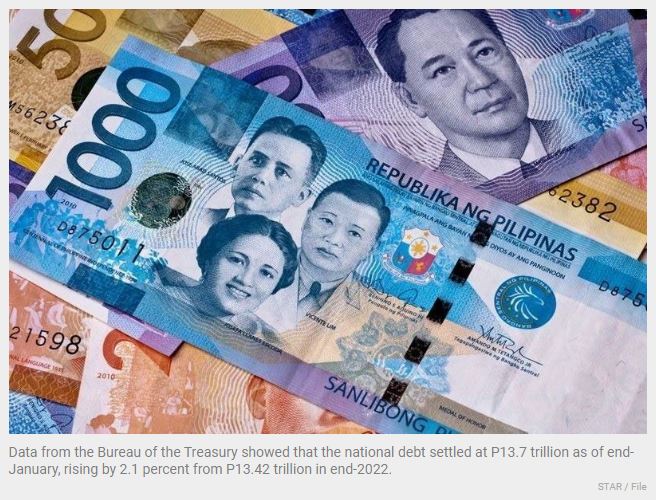Philippine debt balloons to P13.7 trillion in January
MANILA, Philippines — The country’s outstanding debt jumped to its highest level of P13.7 trillion in January, largely due to the government’s global bond issuance, with further increases expected amid high interest rates globally.
Data from the Bureau of the Treasury showed that the national debt settled at P13.7 trillion as of end-January, rising by 2.1 percent from P13.42 trillion in end-2022.
On a yearly basis, the debt stock increased by 14 percent from P12.03 trillion in January last year.
The latest debt level means that every Filipino owes at least P118,000 if the running debt stock is to be divided among the 116 million population in the country.
At the start of the new year, the Marcos administration borrowed P279.63 billion in fresh obligations from both domestic and external sources.
Since the new government started in July, it has added P906.63 billion in debts.
Rizal Commercial Banking Corp. chief economist Michael Ricafort said the increase in debt in January was largely due to the $3 billion (P165 billion) global bond issuance during the month.
This was the government’s second foray into offshore commercial borrowing through the issuance of triple-tranche dollar and green bonds.
Ricafort also attributed the increase to the country’s wider budget deficit, partly due to higher inflation that in turn increased government expenditures, as well as to higher interest rates and financing costs.
“The outstanding national government debt could still increase for the month of February in view of the government’s P284 billion retail Treasury bond issuance,” Ricafort said.
Last month, the government borrowed a total of P284 billion in the second offering of RTBs under the Marcos administration in a bid to expand state coffers and finance various projects.
For the rest of the year, Ricafort sees no significant easing in the country’s debt level due to more planned borrowing, such as the retail dollar bond in the second quarter, coupled with still high interest rates.
“New official development assistance and other multilateral funding, especially for the country’s various infrastructure projects, would also add to the outstanding debt in the coming months as infrastructure spending increases,” Ricafort said.
Meanwhile, the Treasury said domestic borrowings accounted for the majority or 68.5 percent of the debt pile while the remaining 31.5 percent was sourced externally.
Total domestic debt at P9.38 trillion went up by 1.9 percent on a monthly basis and further jumped by 12.2 percent from P8.37 trillion in January 2022.
The increase was attributed to the net availment of P179.16 billion in domestic financing, which offset the P2.61 billion effect of local currency appreciation against the dollar on foreign denominated onshore securities.
External obligations, on the other hand, picked up by 2.4 percent month-on-month to P4.31 trillion and surged by 17.8 percent from the P3.66 trillion in 2022.
The Treasury said the higher external debt was due to the P186.56 billion in foreign loans and the P10.36 billion impact of local currency adjustments on foreign currency debt valuation.
However, the peso appreciation reduced the peso value of foreign currency denominated debt by P93.84 billion.
Meanwhile, total debt guaranteed obligations went down by 1.3 percent to P393.84 billion due to the net repayment of both domestic and foreign guarantees amounting to P1.12 billion and P210 million, respectively.
Source: https://www.philstar.com/business/2023/03/08/2249984/philippine-debt-balloons-p137-trillion-january


 Thailand
Thailand




